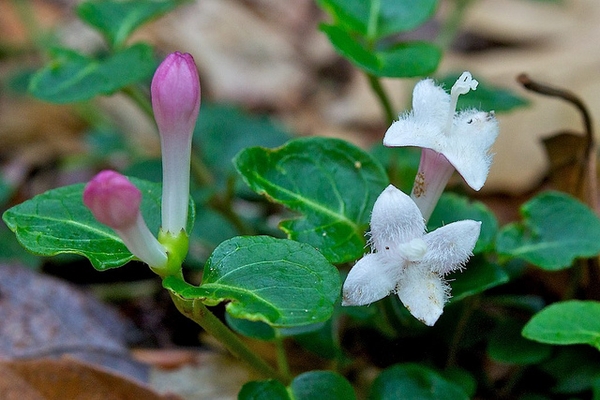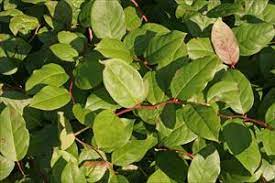Invasive English Ivy and Native Alternatives
By Jenni Hopkins, Fairfax Master Gardener
This article was inspired by one of my neighbors who had a slope of English ivy for the past 24 years and after they found two black snakes in their dryer, that was it. Game on for the eradication of the invasive ivy!
 English ivy (Hedera helix) can become a real nuisance in our gardens and forests over time. This plant is native to Europe, Spain, West Asia and North Africa. It is believed that this evergreen perennial vine was brought to North America many years ago by European settlers as an ornamental plant for their gardens.
English ivy (Hedera helix) can become a real nuisance in our gardens and forests over time. This plant is native to Europe, Spain, West Asia and North Africa. It is believed that this evergreen perennial vine was brought to North America many years ago by European settlers as an ornamental plant for their gardens.
It has since been used for a groundcover and also for erosion control on many difficult slopes. The irony of planting it as an erosion control method is that it does not form extensive underground root systems. Juvenile stems develop adventitious roots that run along the ground and aerial rootlets from the stem which attach themselves to any object. It will attach to and climb trees, buildings, shrubs and utility poles to name a few. It has been noted that their roots are only 1 inch to 4.3 inches deep in the soil in the Washington DC region.
English ivy spreads vegetatively by rooting from the stems or from fragmented roots left in the soil. It reproduces sexually by seed typically in open or disturbed habitats. It is also spread by birds who eat the fruit and disperse the seeds. The birds that act as potential dispersers are cedar waxwing, American robin, Steller’s jay, mockingbirds and house sparrow. The birds will eat the seeds and regurgitate them one at a time, or they may deposit them from their droppings.
The long and short of this is: how do we responsibly and reliably rid our landscape of this highly invasive vine, and what other plants can we use in its place?
Mechanical Control Considerations
One method of control is cutting the vines as close to the ground as possible if climbing a vertical structure. Cutting off the ivy before it flowers will reduce seed production and help to deplete the energy reserves of the plant. Once the vines are cut at ground level, one must pry the vines from the structure. The vines should fall from the tree and will eventually die after the first extended hot and dry period. Unfortunately, if the plant has been on the tree for many years, it can become embedded in the trunk of the tree, which makes control by both hands and chemicals difficult.
You can also mow the area where the ivy is located. The mowing should be frequent, and you must mow the whole area to stop the plants. Mulching the ivy with 6 to 8 inches of mulch for a minimum of two seasons provides another option. For additional control, cover the mulch with cardboard. There are mixed reviews for using a blowtorch to burn the ivy. To be successful with this approach, the plants and resprouts have to be burned repeatedly until the plant’s resources are exhausted. The last mechanical control consideration for a more rural area that has been successful in Oregon is the use of domestic goats browsing the area. The average cover of English ivy was reduced by 23 percent on sites that were browsed for one year.
Chemical Control Methods
Options which include using herbicides can be considered a better control method if you have a large expanse of ivy. Spring will be the best time to apply the herbicide when three to five new leaves appear on the vines. The new growth doesn’t have the waxy cuticle covering on the leaves that allows for better penetration of the herbicide, and the plant has not flowered yet.
Be aware that herbicides vary in their selectivity with some being broad-based or nonselective that may kill a wide variety of species, and others offering a narrow spectrum or selective approach that work on only one or a few species. There are also tendencies for some herbicides to leach through the soil and into the waterways, while some remain in the soil long after the targeted species dies.
This is not an easy solution, so give it much thought on what you want to use to eradicate the ivy and always read the herbicide label before choosing which product is best for your application. If you choose to use a chemical solution for your ivy challenge, and if spraying is required, always spray late in the evening to reduce any impact on nearby pollinating insects. Always read the labels for application rates since the label is the law!
Native Alternatives
If you want to start thinking about other groundcover or shrub alternatives to the English ivy, we have some suggestions. The following are good native considerations for your landscape area.

Partridgeberry
(Mitchella repens) is a creeping woody shrub. It has fragrant white flowers in June through July followed by bright red berries that wildlife enjoy. It prefers shade with moderate watering.
Foam flower
(Tiarella cordifolia) is a clumping perennial that flowers in May with white or pink spires of bloom. It prefers part to full shade with moderate watering.
Creeping phlox
(Phlox stolonifera) is a creeping herbaceous perennial. It blooms from March through May and prefers full sun with moderate watering. It attracts butterflies and is deer and drought resistant.
Wild ginger
(Asarum canadense) thrives in nutrient rich soil and is deciduous. It displays tiny bell shaped flowers from April through May and spreads slowly through rhizomes. It prefers partial to full shade and moist soil conditions.
Lady fern
(Athyrium filix-femina) grows in well-drained soil with partial to full shade. It can tolerate drier soils than most ferns and is deciduous.

Shrub yellowroot
(Dryopteris intermedia) grows in well-drained soil with partial to full shade and provides nice winter interest. It prefers consistent moisture.
Allegheny spurge
(Pachysandra procumbens) is a shrubby groundcover best grown in acidic, organically rich, well drained soils in partial to full shade. It has flowers that bloom from March through April. It is drought tolerant and can thrive in heavy shade.
Shrub yellowroot
(Xanthoriza simplicissima) is a deciduous shrub that prefers an evenly moist, acidic, well-draining soil in partial shade. It flowers in early spring with chains of tiny yellow to brownish-purple stars hanging from the naked stems. This plant tolerates deer, drought, heavy shade and clay soil that can be wet or dry.

Salal
(Gaultheria shallon) is an evergreen with glossy, waxy foliage. It has fuzzy white or pink flowers that bloom in the spring with bluish to black berries that birds love. It is best when in evenly moist soil in partial to full shade.
Longleaf mahonia
(Mahonia nervosa) is an evergreen that has yellow flowers in the late winter to early spring. These are then followed by a purple-blue fruit in the fall. This plant will perform well in moist, well-drained soil rich in acidic humus and in light to full shade. This plant will tolerate dry soil, root competition and airborne salt.
Obviously, the eradication of the English ivy will require a well thought-out plan, perseverance and patience. It may take several seasons to completely rid your landscape of it entirely, but with consistent effort you will be able to take control of it and then plant something more beneficial for you and your wildlife friends. You have options!
References
• Hedera helix, Melissa A. Waggy, Fire Effects Information System, U.S. Department of Agriculture
• English Ivy, Becky Koepke-Hill and Greg Armel, University of Tennessee Extension
• Exotic Invasive Plants, Jennifer Gagnon, Virginia Cooperative Extension
• Exotic Invasive of the Quarter: English Ivy, Jennifer Gagnon, Virginia Tech Department of Forest
Reserves and Environmental Conservation
• English Ivy Control, Joey Williamson, Clemson University Cooperative Extension
• Native Alternatives to Invasive Plants, first edition, by C. Colston Burrell